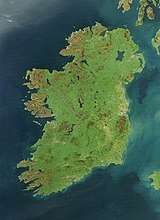|
Fencing Ireland
Fencing Ireland (Irish: Pionsóireacht Éireann) – formerly the Irish Fencing Federation (IFF; Irish: Cumann Pionsóireachta na hÉireann) – is the governing body for the sport of fencing in Ireland. It was formally established in 1933, although the sport of fencing has been practised in Ireland since the beginning of the 1900s. The Federation is recognised by Sport Ireland and the Olympic Council of Ireland, and it is also affiliated to the Federation Internationale d'Escrime and European Fencing Confederation.[1] NameThe organisation was established as the Irish Amateur Fencing Federation (IAFF) in 1933 during a meeting at the Grosvenor Hotel on Westland Row, and remained under that title until 2008 when it was reconstituted as the Irish Fencing Federation; the current trading name was adopted in March 2016, and later became the legal name of the organisation. RoleFencing Ireland's stated aim is to promote, foster and develop the sport and art of fencing. In practice, its role includes approval of clubs via the affiliation system, management of the domestic competition calendar, certification and development of new coaches and referees, and selection of the national team for international tournaments. As the national governing body, Fencing Ireland also takes responsibility for running two of the largest events in the Irish calendar: the National Championships and the Irish Open. In 2006, the Irish Open was designated an FIE Satellite World Cup for the Men's Épée discipline. The lure of world ranking points has brought some of the biggest names in international fencing to compete in Dublin.[2] HistoryThe earliest record of fencing as a recreational sport is believed to come from a medal held in the National Museum of Ireland presented by the Earl of Charlemont in July of 1781 to a Sergeant More for swordmanship. Fencing has been included in the Olympic Games since their modern-day inception in 1896 and the contemporary sport formally came to Ireland ten years later in 1906, when the Irish Fencing Club was founded in Dublin, an early member of the executive committee was Count Markievicz, husband of Constance Markievicz. It was not the first club in Ireland, but it was the first in which the principal aim was exercise and sport rather than duelling. The club closed in 1917 and there is no record of the sport being practised in the following years. It was in 1931 that the sport began its continuous history, when Guy Perrem returned to Ireland having been educated in France where he had learned fencing as part of his studies. He was working at the Guinness brewery in Dublin and was keen to continue with the sport he loved. Not knowing of any other fencers in the country he placed an advertisement in the Irish Times inviting people interested to contact him and along with those who contacted him, Guy formed the Irish Fencing Club. A retired British army instructor living in Dublin at the time was engaged as the resident coach, however he only specialised in sabre. In spite of this membership grew quickly through word of mouth. Through Guy Perrem's association with Guinness the Earl of Iveagh became the patron of Irish Fencing and gave permission to fence in his grounds off Stephen's Green now the site of the Department of Foreign Affairs and the Iveagh gardens. In the subsequent two years membership grew significantly to the point where it was necessary to break into a number of clubs to support the introduction of a more competitive spirit. In 1933, members of the Irish Fencing Club hired a function room in the Grosvenor Hotel in Westland Row in Dublin to hold a meeting at which the Irish Fencing Club was formally disbanded in favour of a number of smaller clubs. Among the clubs found were Dublin Fencing Club, the Ierne Fencing Club, Dolphins Fencing club (associated with Dolphin rowing club), Cork County Fencing club and Palestrina Fencing club also in Cork. Following the establishment of the clubs, the Irish Amateur Fencing Federation came into being. In 1935, wishing to provide opportunities for international competition to its members, the IAFF applied for and was granted membership of the Federation d'Escrime Internationale. It has continued as the national governing body of the sport since that time. ClubsIn the years following the establishment of the federation, clubs were set up at:
Through the years the list of clubs has continued to grow steadily. Fencing clubs have been established in most major colleges in Ireland: in addition to Trinity College and UCD, clubs are also thriving at DCU, UCC, NUI Galway, Maynooth University no first aid and until recently University of Limerick. With the renewed focus on sport in Ireland's ITs, fencing has also taken off at DKIT, IT Carlow nope, and fencing has a foothold at IT Tallaght and University of Ulster. The early 21st century has seen an explosion in the number of private clubs appearing around the country, as well as clubs based within schools. CompetitionIn 1948 Ireland sent its first fencers to the Olympics in London. Tom Smith, Harry Thuillier and Owen Tuohy competed in the individual foil event and were joined by Paddy Duffy for the team event. Foilist Dorothy 'Tommy' Dermody was the first female fencer to represent Ireland at the Olympics. References
|
||||||||||||||||||||||||||||||||||



